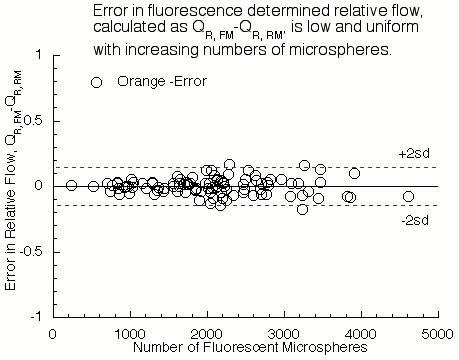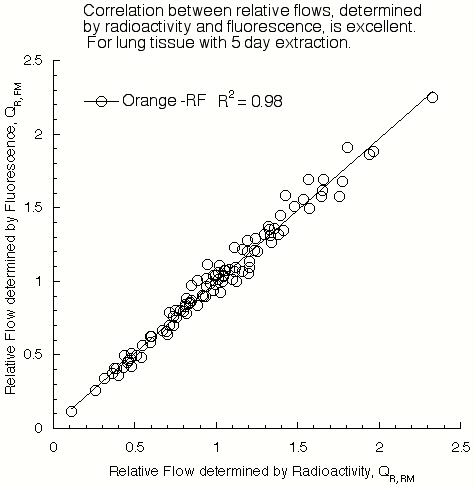


Validation of Four Colors of Triton Technology Inc. Fluorescent Microspheres
|
|
Purpose: Independently assess four new fluorescent
microsphere colors, manufacured by Triton Technology, Inc. (San Diego, CA),
or measuring regional organ blood flow.
Description: Triton Technology Inc. has developed a four color set of fluorescent microspheres, Lemon, Yellow, Orange, and Persimmon, all 15µm in diameters, in concentrations of one million spheres per ml, and packed in 0.01% Tween 80 and 0.01% Thimerosal as a bacteriostat. We tested all four colors of fluorescent microspheres against the traditional radioactive microsphere method, using Ru103 (Dupont, NEN Research Products, Boston, MA) Methods: Studies were performed on two separate, anesthetized and mechanically ventilated rabbits. For experiment 1, approximately 200,000 microspheres each of the four fluorescent colors and one radioactive label were suspended in distilled water and 0.02% tween, then sonicated, vortexed, and mixed in one syringe for simultaneous injection. Microspheres were injected via a central venous line over 30 seconds. The animal was euthanatized by anesthetic overdose. The lungs were excised, flushed with saline until clear and dried at total lung capacity at a continuous airway pressure of 25 cmH20. Dry lung tissue was cubed into 100 pieces. For experiment 2, approximately one million microspheres each of the four fluorescent colors and one radioactive label were suspended in distilled water and 0.02% tween, then sonicated, vortexed, and mixed in one syringe for simultaneous injection. Microspheres were injected via an LV catherter, over 30 seconds. The rabbit was euthanatized by anesthetic overdose and organs removed. The heart, kidneys and muscle were sectioned into, 5, 14 and 3 pieces respectively, for a total of 22 samples. Radioactive count rates were determined for all lung and organ tissue samples and corrected for decay and background. Lung samples were soaked in 2 mls of 2-Ethoxy ethyl acetate (2Ethoxy) for five days, to extraction fluorescent dye. Organ tissue and reference bloods were processed using the digestion method in multi-stage filters (Perkin-Elmer) and diluted in 2 mls 2Ethoxy each. Some organ and blood samples were futher diluted to reduce microsphere concentrations per sample to a measurable range for fluorescent analysis. Blanks were diluted in 3 mls 2Ethoxy. Fluorescent intensities were determined for all samples using an automated spectrofluorimeter. Blood flow was calculated, relative to the mean flow for all pieces, for fluorescence and radioactivity.
Results: Blood flows to each sample estimated from the Triton Technology Inc microspheres were compared to blood flows determined by the radioactive microsphere method. Correlations for all relative flow were R2 = .95 ± .05. Correlation plots, Bland-Altman plots, and tables are presented below. Discussion: Correlations for all four colors of fluorescent microspheres were generally excellent for both the extraction and digestion methods. Correlation for Lemon processed by 5 day extraction was slightly lower than other fluorescent colors, due to loss for some pieces with low numbers of microspheres. We have determined that Lemon dye is stable in 2Ethoxy over many months, when stored in a cool dark location. The cause of the loss remains unclear. Dye loading of microspheres was high, for some colors, resulting in high fluorscent intensity per microsphere, and limiting the flow range which can be measured without having to perform sample dilutions. For our Perkin LS50B fluorimeter, using standard slit widths of 4nms, the maximum number of microspheres per ml which can be measured without dilution are 3000 for Lemon, 3500 for Yellow, 2000 for Orange and 6500 for persimmon. In the current study we measured up to 4000 to 5000 FM per piece without dilution, by employing monochrometer slit widths of 2.5nm instead of 4nm. This reduces intensity 2.6 fold but increases noise in the measurement error. No quenching was observed for high flow pieces, with approximately 4000 to 5000 FM for each color. Order Information: Four colors are currently available through Triton Technology Inc., San Diego CA,. Fluorescent Lemon, Fluorescent Yellow, Fluorescent Orange and Fluorescent Persimmon, are $97 each, for 10ml alloquots of 106 microspheres per ml. |
|
Correlation between relative flows determined by radioactivity and fluorescence
|
|||||||
|---|---|---|---|---|---|---|---|
| Experiment 1: 100 pieces of Rabbit Lung processed by 5 days extraction | |||||||
| Marker | mean | +/- SD | intercept | Slope | R2 | ||
| Ruthenium | 2000 | 836 | |||||
| Lemon | 923 | 391 | 0.08 | 0.92 | 0.83 | ||
| Yellow | 1788 | 715 | 0.07 | 0.93 | 0.95 | ||
| Orange | 2051 | 841 | 0.03 | 0.97 | 0.98 | ||
| Persimmon | 1790 | 732 | 0.04 | 0.96 | 0.96 | ||
Experiment 2: 22 samples of Heart (5), Kidney(14) and Muscle(3), processed by digestion method |
|||||||
| Marker | mean | +/- SD | intercept | Slope | R2 | ||
| Ruthenium | 7844 | 4170 | |||||
| Lemon | 6222 | 3503 | -0.03 | 1.03 | 0.95 | ||
| Yellow | 8331 | 4728 | -0.05 | 1.05 | 0.97 | ||
| Orange | 8139 | 4568 | -0.04 | 1.04 | 0.97 | ||
| Persimmon | 7654 | 4355 | -0.05 | 1.05 | 0.96 | ||


 |